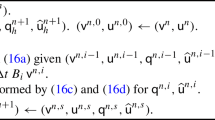Abstract
We provide an error analysis of two methods for time stepping the wave equation. These are based on the Hybridizable Discontinuous Galerkin (HDG) method to discretize in space, and the continuous Galerkin method to discretize in time. Two variants of HDG are proposed: a dissipative method based on the standard numerical flux used for elliptic problems, and a non-dissipative method based on a new choice of the flux involving time derivatives. The analysis of the fully discrete problem is based on simplified arguments using projections rather than explicit interpolants used in previous work. Some numerical results are shown that illuminate the theory.




Similar content being viewed by others
References
Akrivis, G., Makridakis, C., Nochetto, R.H.: Galerkin and Runge–Kutta methods: unified formulation, a posteriori error estimates and nodal superconvergence. Numer. Math. 118(3), 429–456 (2011)
Brenner, S.C., Scott, L.R.: The Mathematical Theory of Finite Element Methods, 3 ed. Texts in Applied Mathematics, vol. 15. Springer, New York (2008)
Cockburn, B., Gopalakrishnan, J., Lazarov, R.: Unified hybridization of discontinuous Galerkin, mixed, and continuous Galerkin methods for second order elliptic problems. SIAM J. Numer. Anal. 47(2), 1319–1365 (2009)
Cockburn, B., Gopalakrishnan, J., Sayas, F.-J.: A projection-based error analysis of HDG methods. Math. Comp. 79(271), 1351–1367 (2010)
French, D.A., Peterson, T.E.: A continuous space-time finite element method for the wave equation. Math. Comput. 65(214), 491–506 (1996)
Geveci, T.: On the application of mixed finite element methods to the wave equations. RAIRO Modél. Math. Anal. Numér. 22(2), 243–250 (1988)
Griesmaier, R., Monk, P.: Error analysis for a hybridizable discontinuous Galerkin method for the Helmholtz equation. J. Sci. Comput. 49(3), 291–310 (2011)
Grote, M.J., Mitkova, T.: Explicit local time-stepping methods for Maxwell’s equations. J. Comp. Appl. Math. 234(12), 3283–3302 (2010)
Hairer, E., Nørsett, S.P., Wanner, G.: Solving Ordinary Differential Equations. I. Nonstiff Problems, 2 ed., Springer Series in Computational Mathematics, vol. 8. Springer, Berlin (1993)
Hairer, E., Wanner, G.: Solving Ordinary Differential Equations. II. Stiff and Differential–Algebraic Problems, 2 ed. Springer Series in Computational Mathematics, vol. 14. Springer, Berlin (1996)
Karakashian, O., Makridakis, C.: A space-time finite element method for the nonlinear Schrödinger equation: the discontinuous Galerkin method. Math. Comput. 67(222), 479–499 (1998)
Karakashian, O., Makridakis, C.: A space-time finite element method for the nonlinear Schrödinger equation: the continuous Galerkin method. SIAM J. Numer. Anal. 36(6), 1779–1807 (1999)
Karakashian, O., Makridakis, C.: Convergence of a continuous Galerkin method with mesh modification for nonlinear wave equations. Math. Comput. 74(249), 85–102 (2005)
Kirby, R.M., Sherwin, S.J., Cockburn, B.: To CG or to HDG: a comparative study. J. Sci. Comput. 51(1), 183–212 (2012)
Nguyen, N.C., Peraire, J., Cockburn, B.: A hybridizable discontinuous Galerkin method for Stokes flow. Comput. Methods Appl. Mech. Eng. 199(9–12), 582–597 (2010)
Nguyen, N.C., Peraire, J., Cockburn, B.: High-order implicit hybridizable discontinuous Galerkin methods for acoustics and elastodynamics. J. Comput. Phys. 230(10), 3695–3718 (2011)
Schötzau, D., Schwab, C.: Time discretization of parabolic problems by the hp-version of the discontinuous Galerkin finite element method. SIAM J. Numer. Anal. 38(3), 837–875 (2000)
Author information
Authors and Affiliations
Corresponding author
Appendix
Appendix
1.1 Projection Estimate on the Element Boundaries
In this section we give a proof of the projection estimate on the element boundaries (4c). Our arguments rest on those used in [4] to prove the corresponding interior estimates (4a) and (4b).
We start with a slight modification of Lemma A.2 of [4].
Lemma 6
Let \(K \in \mathcal{T _h}, \tau \) as introduced in Sect. 2.1, and suppose
satisfies
where \(b: \mathcal{P }_k^\perp (K) \rightarrow \mathbb R \) is linear. Then
where \(\Vert b\Vert \) denotes the operator norm of \(b\) with respect to the \(L^2\)-norm on \(\mathcal{P }_k^\perp (K)\).
Proof
Denoting by \(F\) the edge/face of \(K\) at which \(\tau = \tau _K^{\max }\),
Using the estimate
which has been shown in Lemma A.1 of [4], gives
\(\square \)
The following proposition should be compared to Proposition A.2 of [4].
Proposition 1
Suppose \(k \ge 0\), and let \(K\in \mathcal{T _h}\) and \(\tau \) as introduced in Sect. 2.1. Then,
for \(\ell _w, \ell _{\varvec{z}}\in [0,k]\).
Proof
Denoting \(\delta ^w := \varPi _W w - w_k\), where \(w_k\) is the \(L^2\)-projection of \(w\) onto \(\mathcal{P }_k(K)\), we have
Applying a trace inequality and the approximation properties of the \(L^2\)-projection the first term can be estimated by
To estimate the second term we recall that on each element \(K \in \mathcal{T _h}\) the component \(\varPi _W w\) satisfies
(see Proposition A.1 of [4]). This implies that \(\delta ^w \in \mathcal{P }_k^\perp \) and
where \(b_w(\phi ) := \langle \tau (w-w_k), \phi \rangle _{\partial K}\) and \(b_{\varvec{z}}(\phi ) := ({{\mathrm{\nabla \cdot }}}{\varvec{z}}, \phi )_K\). It has been shown in the proof of Proposition A.2 in [4] that
Since by Lemma 6,
this ends the proof. \(\square \)
Rights and permissions
About this article
Cite this article
Griesmaier, R., Monk, P. Discretization of the Wave Equation Using Continuous Elements in Time and a Hybridizable Discontinuous Galerkin Method in Space. J Sci Comput 58, 472–498 (2014). https://doi.org/10.1007/s10915-013-9741-9
Received:
Revised:
Accepted:
Published:
Issue Date:
DOI: https://doi.org/10.1007/s10915-013-9741-9
Keywords
- Discontinuous Galerkin method
- Hybridization
- Continuous time Galerkin method
- Error analysis
- Wave equation




